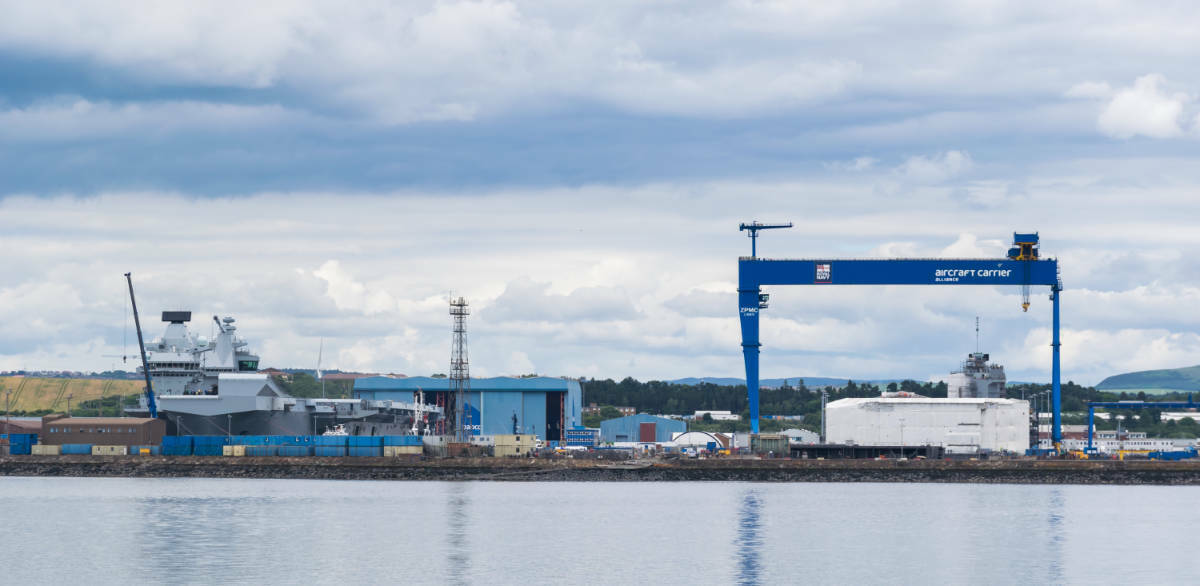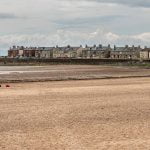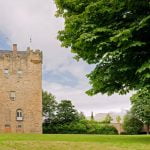
One of the original Garden Cities, Rosyth is one of Fife’s star attractions.
The whole stretch of coastline up around Fife is some of the best you will see. Granted, it’s not as rocky as the run up the east coast past Edinburgh, and it isn’t quite as jaw-dropping as the Scottish Highlands, but you will find one of the best beaches in Scotland, complete with caves to explore, right on your doorstep. Rosyth is a tourist’s haven and well it should be. This area of Scotland traditionally stood as a battleground between the Highlanders and the Lowlanders. It doesn’t get nearly the fanfare that it deserves.
Until now. When we treated it to one of our signature Five Minutes Spare travel guides. Hop on the tour bus. Today we are talking about all things Rosyth.
The Quick Rosyth Overview
Rosyth was originally a Garden City. This innovative concept involved working people and residences around the countryside, instead of the opposite way. What resulted from the building of the Garden Cities were popular areas to live, where plants and animals have just as much right to traffic as humans do. In Rosyth, they kind of ruined it a little by adding in a massive naval base and port, both of which started building work just after the government appointed the town a Garden City. The modern dockyard is about 13000 square meters in size. The naval base closed in 1994 but the ships still dock here to be fixed. The site was the first in the navy to become privatised and is still in the hands of those who bought it.
The naval base at Rosyth played a key role in the World Wars. The dry docking area allows for the repair of damaged vessels in the relative safety of the harbour. In the late 90s, the base was refurbished to repair nuclear submarines. This makes it Britain’s only port capable of refitting a nuclear submarine. This is a classic example of sticking your nukes up in Scotland where they didn’t vote for them so that you protect the important populations down south. We notice it. We tolerate it. One day we will not.
Although it grew up as a naval base and port town, the area of Rosyth has been occupied for far longer than this. We know there was a population living here up until the 18th century. We know this because the castle, owned by Robert of Rosyth, fell into disrepair and out of use in the 1800s. Prior to falling out of use, it housed the Rosyth’s family from 1384. The castle saw hundreds of years of use before it was dilapidated. Much of that use was as the seat of the Barony of Rosyth. It even once housed clan Stuart for a time.
Let’s talk more about the clans that lived here before the navy moved in.
The Clans of Rosyth
We love to learn about the Scottish Clans of any given area we investigate and Rosyth is no exception. Notably, the castle was owned by the Hopetoun family. The Lindsay family are from this area, and the Clan Primrose shares its name with one of Rosyth’s housing estates. The Clan Buchan came from this area. They have a town named after them. After an English invasion in 1296, the clan Baxter was forced to swear fealty to Edward I. Other Fife clans include the famous clans of Stuart and Bruce. The two most notable, however, are clan Lindsay and Clan Buchan, so let’s look at them in a little more detail.
Clan Buchan
Clan Buchan is a “sept” of the Clan Cumming. A sept is like a descendant of that clan. They are named for the stretch of land near the River Don and their first member was Ricardus de Buchan, clerk of the Bishopric of Aberdeen, in 1208. The Cummings held the title of Earls of Buchan until Robert the Bruce took it from them. The titles reverted to the crown in 1406 after Robert The Bruce’s great-grandson, the Wolf of Badenoch, died. The Buchans were a warlike people who fought for the crown and against the crown. The title passed to the females to the Erskine family later down the line. The Buchans own the land of Auchmacoy. They were staunch supporters of house Stuart and fought against William of Orange.
Clan Lindseay
Clan Lindsay was massive. They covered intermittent portions of Scotland and spread their name everywhere. Their lineage traces back to 1124, when Sir Walter de Lindeseva went with King David to Scotland. In 1180, William de Lindsay was baron of Luffness and the Laird of Crawford. His grandson has signed his name on the Declaration of Arbroath as a witness. They were at the battle of Brechin. They were fighting for the Royalists in the Civil War. They have been secretaries of State, written plays, and helped invent wireless telegraph systems. A Lindsay was once appointed Master of Balliol College. You find Lindsays in Lanarkshire, Ayrshire, Dundee, Forfarshire, the Scottish Borders, and in Fife. They were a prolific clan and they still are to this day. Clans like the Lindsays shaped Scotland. It’s a proud thing to be part of if you share their name.
But enough about the clans. Let’s get back to the history of Rosyth itself.
The Medieval Period in Fife
The castle was remodelled in the 16th and 17th centuries, so it was still seeing occupation until then. The castle was last sold in 1903 into the hands of the Admiralty and now belongs to the Navy. It’s still worth a visit, even though it is in ruins now. Throughout the medieval era, the castle was reportedly too remote to support a town, although a few households always show up where there are castles. Castles need servants and cooks, cleaners, and stable hands. So Rosyth is older than we think, as to how old, we would be guessing. There’s no mention of the Romans here since they didn’t get passed the wall. We know most of the early history of English towns because the Romans wrote it down. Ancient Scots were more campfire-tale-inspired than anything with pen and paper. They thought writing was spelling, and spelling was for witches. To be fair, you can’t fault their logic.
Fun Facts About Rosyth
In this section of the article, we always put aside time to get to grips with the local gossip. Here are a few fun trivia items you should know about Rosyth before you go. Surprise your family with local lore or look like you know your stuff on a dinner date. Either way, here are the fun things you should know about Rosyth:
- Rosyth was a Garden City, founded in 1909 to try to blend city living with natural habitats. For the most part, the experiment worked. Welwyn is a better-known garden city that you can read about in our guides.
- Although not technically inside Rosyth, the town has a Dockyard on the Firth of Forth. This large dockyard is currently owned by Babcock Marine. There is a small cruise terminal here used for day trips.
- Rosyth has a Morthouse in the cemetery. These were popularised after Scottish grave robbers Burke and Hare were found snatching dead bodies to sell to the boffins at the university in Edinburgh. After that, bodies were interred overnight in a Morthouse to protect them until burial. They were then buried under iron bars to keep the grave robbers out. Burke and Hare killed more than 17 people in their escapades. Although historians believe the true number of stolen or killed bodies, they harvested was nearer 30.
- Although originally a Garden City, Rosyth was like no other Garden City you have heard of before. It was planned to accommodate the deep water docks and then house the construction and dockyard workers. It was less planned to incorporate nature, and more so desolate down there that they thought they better house them or lose them.
- Rosyth Docks was the construction place of the largest ship in the Royal Navy. More on this below.
And on that abysmal note, let’s leave off from the supposed-to-be fun facts and turn our attention back to history. Modern-day Rosyth has a bit more to answer for than ancient-day Rosyth, at least in terms of sailors.
Industrial Era Rosyth
Rosyth missed the industrial period. In fact, it missed everything right up until 1909. When locals first planned it out, the town was already housing thousands of dock workers before it had houses to put them in. In those days, the government had a great solution for this known as pre-fabricated housing. These were no more than storage containers with corrugated iron roofing to keep the rain out. They were designed for use in the south of England but did make it all the way north to Scotland… where it is much, much colder. The boomers of 2022 lived in these pre-fabs after the war. In some places in Scotland, the pre-fabs were still in play until the late 70s.
As a result of the hundreds of pre-fab homes, Rosyth was known as Tin Town for a while. It was later known as Bungalow City. The town was still in the tin until 1956 as early photographs of the area show. Food was cheap, rent was low, and the atmosphere was bracing. The position on the remote stretch of land made everything windswept. This is a problem Rosyth has not conquered yet, today.
The Modern Town
Rosyth has a suitably Scottish heart. In 1919, when the rent prices on the tin houses went up, many families faced eviction. 12 tenants became homeless overnight. 3,000 other residents of the docks in Rosyth blocked the dual carriageway near town to prevent the trade from moving. The tenants didn’t get their houses back and the strike collapsed. Later and with great irony, the reduction to the docks saw rents drop dramatically.
In 1926, the Navy and Rosyth dockyard both reduced in size. The town shrunk, along with its economy.
During the wars, the town had a huge part to play in some subterfuge. Being a naval base, the town didn’t suffer sea attacks. Rather, they helped salvage a bunch of beaten German vessels off the coast by bringing them in. This let the navy pinch their tech and since the vessels were brought to a dry dock, up several vessels, too. This was during WWII when the German fleet fell fowl at Gutter Sound.
The dockyards faced privatisation in 1987 however they retained their shipbuilding prowess. Most recently it was the construction site of HMS Queen Elizabeth the current fleet flagship for the Royal Navi. The Queen named the Aircraft Carrier at Rosyth docks on 4 July 2014. She broke with tradition by instead of smashing the traditional bottle of champagne on the hull, it was christened with a bottle of fine Bowmore Whiskey!

HMS Queen Elizabeth The 3rd Largest Aircraft Carrier in the World.
Imahe: Kevin Shipp/Shutterstock.com
Modern Rosyth is not as large nor as bustling as it used to be. It is still an important port town but its remoteness makes it a windy drive. Be sure to pack your parka and your umbrella. There’s great shopping and food here, so take advantage of the sea breeze and enjoy some fresh fish.
Famous People from Fife and Rosyth
There are not so many famous people in Scotland as there are in England. It has something to do with who you know and where you are born. Those born in London city with access to the studios are at a distinct advantage over those born in the wilds of Fife. On the other hand, if you want footballers and golfers, Scotland is your country. Here are some of the famous people from Rosyth and the surrounding areas:
- Scotland striker Stevie Crawford, of the Crawford clan of Norman descent, is a pro footballer from Rosyth. Interesting historic note, the Crawford’s intermarried with the Campbells, so you find them as far north as the Highlands.
- Singer and actor Barbara Dickson, who you may or may not recognise has had 47 songs in the charts.
- Gregory Burke, who wrote the play “Black Watch” was born here.
- Robert Buchan, an engineer that moved to Canada to find fame, was born here.
- John Hay Munro, the evangelist.
- Andy Penman was from here, a former Scotland player.
We told you, it’s always footballers up this side of the border. Although a prolific singer nobody has heard of really took us by surprise. Anyway, on to everyone’s favourite part – the attractions.
The Best Things to See and Do in Rosyth
Now that we have made it to the good bit, let’s talk about interesting places to go and fun things to see and do. Here’s the scoop on the best bits of Rosyth.
Historic sites and Landmarks
Obviously, you must see Rosyth castle. The 15th-century building lies on the edge of the dockyard, where it has overseen the shore here for generations. It has great views of the Firth of Forth. When the castle first opened, it was connected to the land by a short causeway. Now it is on the shore. The tower house and small courtyard remain although they are in ruins.
The biggest local landmark is the Forth Road Bridge. This bridge famously cost hundreds of lives when first built. The height and the danger of the job meant the men that finally finished the task were treated like heroes. The Forth Road Bridge is an architectural marvel, especially when you consider the first incarnation of it opened in 1890. The toll bridge became free in 2008. 7 men died in the most recent bridge’s making in 1964.
Galleries and Museums
The nearest museums to Rosyth are less traditional than you might expect. The town has its own museum, of course, known as the Inverkeithing Museum. It holds local historic artefacts, a small gallery for fine art, and runs exhibits throughout the year.
You will find what is described as an open-air museum out of town and towards Dunfermline. You can, if you feel inclined, go and visit the memorial of Clan Chief Hector MacLean of Mull nearby. He died at the Battle of Inverkeithing in July 1965. This battle was one of the Wars of the Three Kingdoms. Unfortunately, the English took hold of the Firth of Forth through this battle, which allowed Oliver Cromwell to control trade here.
Outdoor Attractions
Rosyth Public Park is the local area for sunbathing. It has football grounds and rugby grounds, an area for dog walkers, and some trees. It is suitable for picnicking but beware of potential ball games. Locals hold gala day celebrations here in the summer, where you get a parade, candy floss, and a few well-placed theme rides.
Rosyth is a deep water port which means it doesn’t have its own beach. You can right this tragedy by visiting the gloriously sandy Inverkeithing beach to the north a little around the coast. If you keep heading in that direction, you will also come to the Silver Sands Beach of Aberdour.
Sports and Recreation
You can go along to watch the Rosyth Sharks, the local Rugby Union Club that play in town. The Rosyth sharks have a long history of 30 years and counting. Rugby is a popular sport this far north, where if you are not tossing cabers, your strength is being wasted. Join the RUFC in Rosyth on their Facebook page. Because 30 years isn’t long enough to set up a website.
Rosyth Football Club has both a seniors team and a youth team. They play in the East of Scotland leagues. Up until 2006, the team were the Rosyth Recreations. The youth club began back in 1916 and everyone took a break from the war. It’s a good setup and it’s setups just like this all over Scotland which makes football the national sport… or is it golf?
There is no named Rosyth golf club, but a search on a local golfing app shows there are 63 clubs within driving distance… see what we did there? The nearest and highest rated include the Pitreavie Golf Club in Dunfermline, the Forrester Park Resort Golf Course for the high-end players, and the Dunfermline Golf Club located to the east of the city, not far from Rosyth.
Shopping and Retail
Rosyth is an industrial town with a long history of boating activity. Most of the shops in town are warehouses for stock which reflect this. You can find all your grocery suppliers in the high street or visit the Belleknowes Industrial Estate for other types of shops.
Other Notable Fife Attractions
If you have come this far north, you shouldn’t leave without getting your money’s worth. Let’s face it, Rosyth is hardly thick on the ground with seaside attractions. Here are some other sites that are not to be missed:
- There are three churches to choose from: Rosyth Parish Church, The Catholic Church of Saint John and Saint Columba, and the Rosyth Methodist Church. Have fun.
- Visit Flemings furniture and antique centre in Inverkeithing for a nice day out antiquing
- Head south to North Queensferry and visit Deep Sea World
- Take a day trip into nearby Dunfermline
- Take a day trip shopping in Edinburgh
- Head north along that coast again until you reach the popular tourist town of Burntisland
How to Get to Rosyth?
To draw the article to a close then, let’s talk about locations. How do you get to this part of the country and how do you get out again, so that you’re not trapped? Here are our best directions to help you get lost in Fife.
By Road
Head north out of Edinburgh along the coast and follow the A985 until you hit Rosyth.
By Rail
Rosyth train station is on the Fife line.
By Air
The nearest airport is Edinburgh International.
By Sea
Rosyth has its own industrial port but few ferry passengers.
Just Five More Minutes…
Still on your break? We know our audience. Here are some more Five Minutes Spare guides to help you through your shift. If your boss catches you, it was nothing to do with us.



